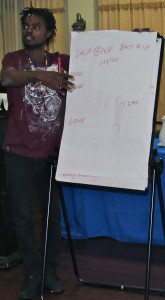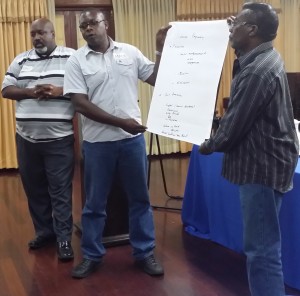
Mentoring Our Vulnerable Boys: Not a Walk in the Park
July 6th, 2016
Have you ever considered mentoring? What are the pitfalls, and what are the rewards?
Panos Caribbean enlisted the expertise of Claudette Richardson Pious, Executive Director of the Children First Agency in Spanish Town, to put prospective mentors through their paces at a recent workshop. Ms. Richardson Pious knows the challenges our young people face only too well. When she listed the hurdles our at-risk boys encounter – not always one at a time, but perhaps each child may have to deal with several in his/her life at the same time – the task of mentoring a boy may seem daunting.
However, the mentors – covering a range of ages and occupations – seemed quite undaunted, because they know that there is an urgent need. The Panos project, under the title From Risk to Resilience: Enhancing the Life Chances of Boys at Risk Inside Two Communities, is funded by the Commonwealth of Learning, an intergovernmental organization created by Commonwealth Heads of Government hosted by the Government of Canada with a focus on capacity-building for developing countries in the area of education and training. It emerged from a series of stakeholder meetings in Kingston and Clarendon – the areas of focus. It will include vocational and skills training, partnering with the HEART Trust; media and communications training, under Panos’ youth journalism program; parenting workshops; and life skills training in areas such as conflict resolution. The aim is to give each boy all-round support and opportunity. And perhaps most importantly of all – hope.
So how does the mentor instill hope in a teenage boy besieged with issues – not only those regular pains of adolescence, but issues such as domestic violence, violence in the community, absent parents, sexual abuse and other agonizing issues. The extreme “macho culture” is harmful to our boys (and girls). There is an energy drink called Boom that is apparently consumed with white rum, which makes the heart race and is obviously bad for any child (there’s a dancehall song called White Rum and Boom). There is the over-use of ganja and its variants. Perhaps above all, there is the need to “prove oneself” – to get a young girl pregnant, or to use a gun. Gangs recruit boys and often get them to fire the guns to confuse fingerprints; or they serve as couriers for gangs. It’s extreme peer pressure.
Our jaws dropped. At-risk boys are struggling to find their way in an unhealthy – one might say toxic – environment, with very little guidance. In many communities, participants in the workshop told us, there is a kind of “every man for himself” mentality. The hackneyed old phrase “It takes a village to raise a child” simply doesn’t apply. It’s a question of survival.
So, it’s unlikely that the at-risk youth can rely on the community for support; nor, sadly, can his school help much, if at all. The over-worked guidance counselors are too busy putting out fires, and are reluctant to sit down and discuss sensitive issues with troubled teens. Teachers are similarly over-worked and stressed.
How can one possibly hope to make a difference in a boy’s life, under these circumstances? In one exercise, the trainee mentors produced powerful drawings that illustrated key aspects of mentorship: trust and honesty, balance and support. There is one very fundamental element, too, in the relationship: the mentor must simply show up. He must be there for the boy; and he must always be prepared to give his time. Before even embarking on mentorship, one must always ask oneself: Can I commit the time that is needed? Because, there is no doubt, it is a commitment, as with one’s own child.
So what should a mentor actually be doing? He should be working alongside the boy, helping with his school work, encouraging him to do better, but never dictating and always seeking to build his belief in himself. A good mentoring relationship is a partnership. The boy himself should identify his goals – what he wants to achieve in life – with some nudging perhaps. The mentor should guide him along a path to progress and a better life. It should not be all the serious stuff all the time, though. Many young people are almost trapped in their communities, unable to escape. So a trip to the beach, a walk in Emancipation Park can be a revelation, a life-changing experience for the boy. It is good for him to enjoy light moments and simple pleasures like eating an ice-cream or taking a sea bath – without any pressure.
I often wonder: Do we adults really understand what pressures our young people are under? It’s so easy to dismiss them, to call them “bad.” They are trying to keep their heads above water, to keep afloat in a sea of negativity.
While the rest of society does not have time for the troubled boy, a mentor must give him that time – quality time. You can’t rush things with teenagers. Even if you have a strong relationship, crises will emerge, especially of the emotional kind. The trainee mentors thought up the worst possible scenarios, and how they would deal with them – recognizing that if a house is on fire, you usually need help to put it out.
“You are not The Savior,” Ms. Richardson Pious reminded the trainee mentors. It is not a question of coming to the rescue.
Mentorship is, largely, about caring.
If you are interested in mentoring a boy, you may contact Panos Caribbean at 22, Westminster Road (Corner Burlington Av.) Kingston 10, Jamaica Email: jamaica@panoscaribbean.com Tel: (876) 920-0070 / 920-0071 And you may find them on Facebook and Twitter @PanosCaribbean. Website: http://www.panoscaribbean.org
Tags: alcohol, children, Children First, Clarendon, Claudette Richardson Pious, Commonwealth of Learning, crime and violence, gang violence, human rights, Jamaica, journalism, Kingston, life skills, macho culture, mentorship, NGO, Panos Caribbean, skills training, Spanish Town, youth at risk, youth empowerment
The Gleaner reserves the right not to publish comments that may be deemed libelous, derogatory or indecent.
To respond to The Gleaner please use the feedback form.
- We Are the Zoomers
- Living Online with Humans and Birds: NAOC 2020
- Human Trafficking and the Problem of Public Education
- Down Memory Lane
- Are We Ready to Recover from COVID-19?
- Road Safety Matters: Is Your Vehicle Safe?
- Sexual Harassment, Me Too, and the Minister’s Disturbing Giggle
- The Vulnerable Senior Citizens, Private Care Homes and COVID-19
- A Muddle Over Masks
- Here is Something Life-Saving You Can Do: Give Blood!





